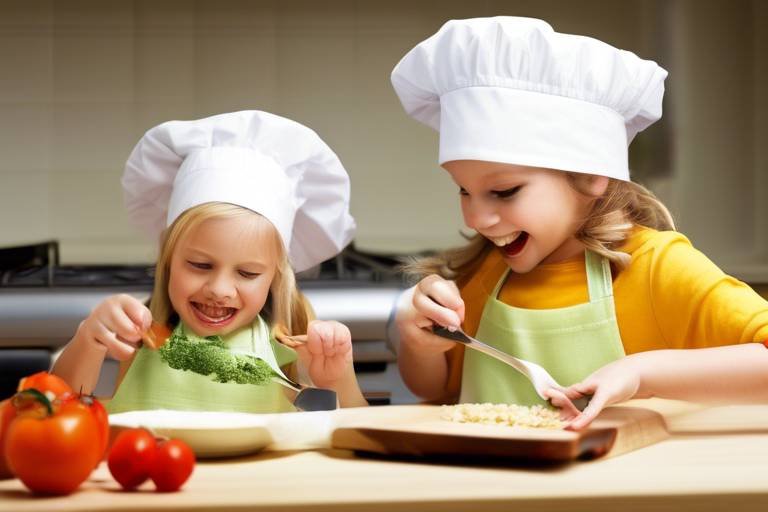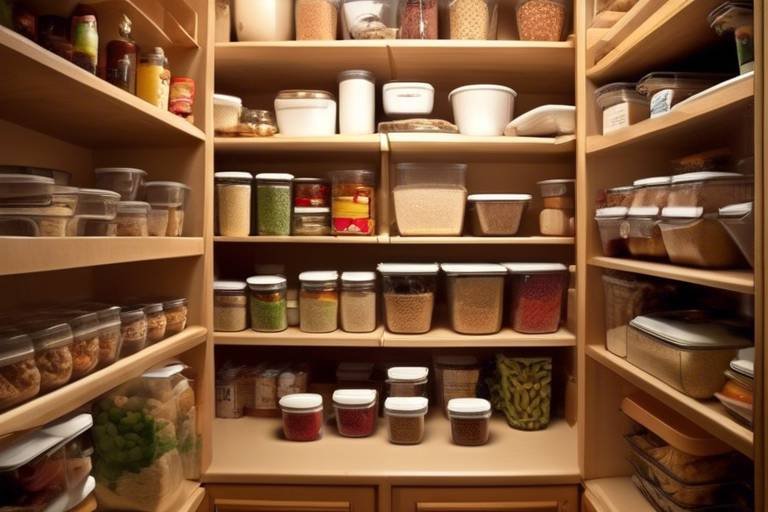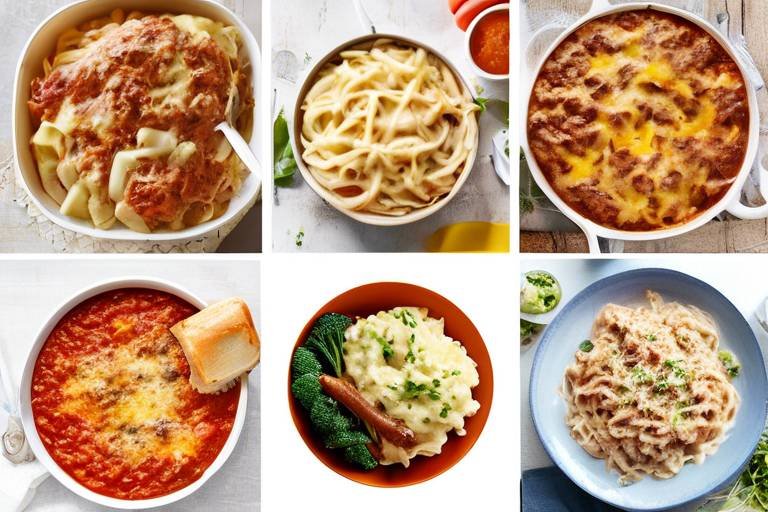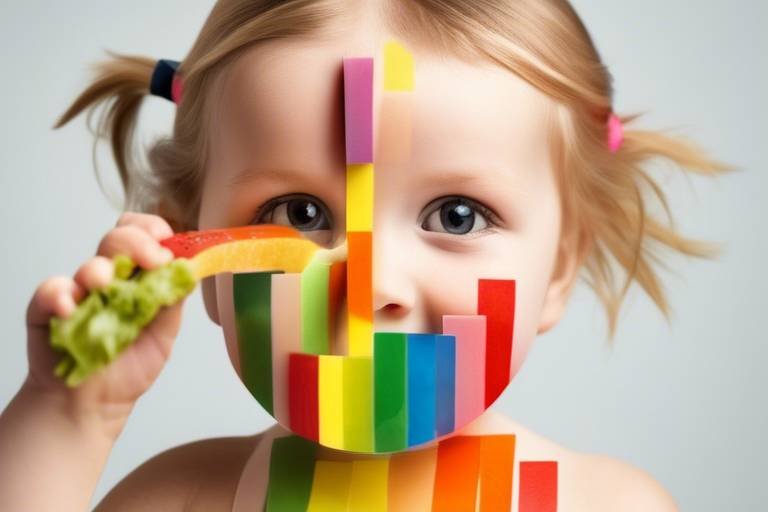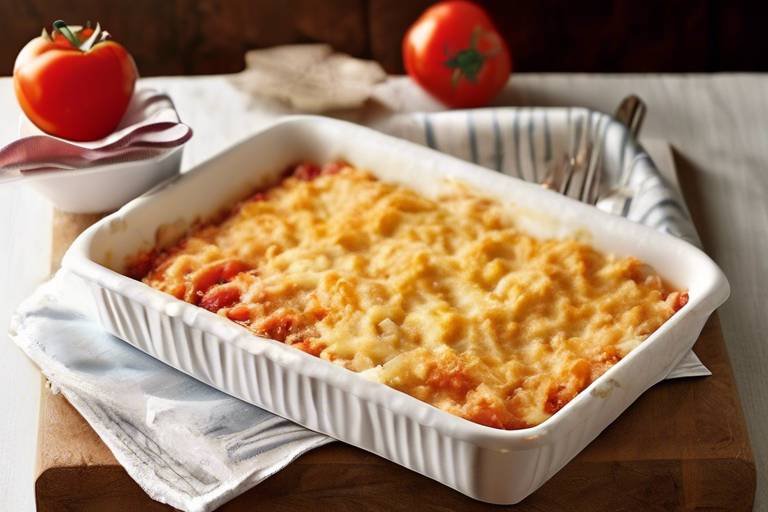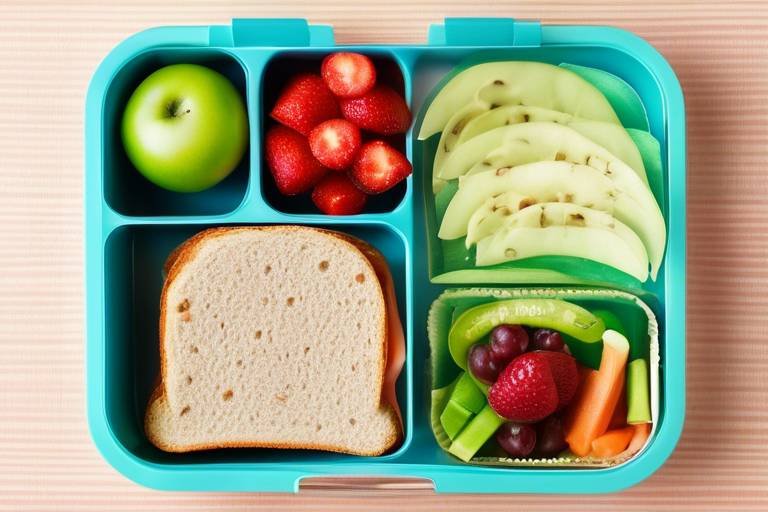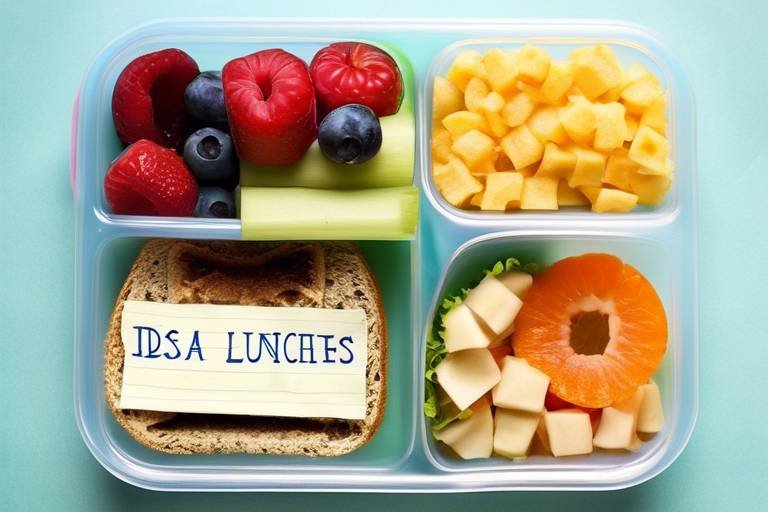Cooking with Kids: Fun and Healthy Recipes to Make Together
Cooking with kids is more than just a way to prepare meals; it's an adventure filled with laughter, learning, and lasting memories. Imagine the joy on a child's face as they mix ingredients, taste new flavors, and create something delicious from scratch. This article explores engaging and nutritious recipes that you can prepare with children, fostering creativity and healthy eating habits while making lasting memories in the kitchen. With the right approach, cooking can transform from a mundane task into a delightful experience that sparks curiosity and encourages kids to embrace healthy eating.
When you cook with children, you're not just teaching them how to follow a recipe; you're opening the door to a world of possibilities. From measuring ingredients to understanding food groups, every step in the kitchen is an opportunity for learning. Plus, the kitchen becomes a canvas for creativity where kids can express themselves through food. Whether it's choosing colorful vegetables or experimenting with flavors, cooking together can ignite a passion for healthy eating that lasts a lifetime.
In this article, we will delve into the benefits of cooking with kids, share some kid-friendly recipes that are easy to make, and provide essential cooking safety tips. So, roll up your sleeves, grab your aprons, and let's embark on this culinary journey together!
Cooking together enhances children's motor skills, boosts their confidence, and teaches them about nutrition. When kids are involved in the cooking process, they learn to measure, mix, and manipulate ingredients, which helps develop their fine motor skills. This hands-on experience not only makes them more adept in the kitchen but also gives them a sense of accomplishment when they see the final product. Moreover, cooking fosters teamwork and communication, as children learn to work alongside adults and express their ideas.
Additionally, cooking can be a gateway to understanding nutrition. Kids are often more willing to try new foods when they have a hand in preparing them. By discussing the benefits of various ingredients, you can instill healthy eating habits that will serve them well into adulthood. Cooking together is not just about making food; it's about creating a foundation for a healthy lifestyle.
Discover a variety of simple and healthy recipes that are perfect for children. These dishes are designed to be fun and easy to make, ensuring an enjoyable cooking experience. From breakfast to snacks, there’s something for every meal that kids will love to help create.
Start the day right with nutritious breakfast recipes that kids can help prepare. These dishes are not only delicious but also provide essential energy for active mornings. A healthy breakfast sets the tone for the day, making it easier for kids to focus and engage in their activities.
Fruit smoothies are a fun and colorful way for kids to enjoy healthy fruits. Mixing different fruits together can be like creating a work of art! You can use ingredients like bananas, strawberries, and spinach to make a delicious and nutritious smoothie. Here’s a simple recipe:
Ingredients: - 1 banana - 1 cup of strawberries - 1 cup of spinach (optional) - 1 cup of yogurt or milk - 1 tablespoon of honey (optional) Instructions: 1. Peel the banana and wash the strawberries and spinach. 2. Add all ingredients into a blender. 3. Blend until smooth. 4. Pour into glasses and enjoy!
Pancake art allows children to express their creativity while making breakfast. Learn how to create fun shapes and designs using simple pancake batter. With a squeeze bottle, kids can draw their favorite characters or shapes on the griddle. It’s like painting, but with delicious results! Here’s a basic pancake batter recipe:
Ingredients: - 1 cup of flour - 1 tablespoon of sugar - 1 tablespoon of baking powder - 1 cup of milk - 1 egg - 2 tablespoons of melted butter Instructions: 1. In a bowl, mix the flour, sugar, and baking powder. 2. In another bowl, whisk together the milk, egg, and melted butter. 3. Combine both mixtures and stir until just mixed. 4. Pour batter onto a hot griddle and create your designs!
This section features healthy and easy lunch and snack recipes that kids can prepare. These options are perfect for school lunches or after-school treats. Involving children in the preparation of their meals can make them more excited about eating healthy.
Safety is paramount when cooking with kids. This section provides essential tips to ensure a safe and enjoyable cooking experience for both children and adults. Always supervise children closely, especially when using sharp knives or hot surfaces. It's crucial to teach them about kitchen safety and hygiene, such as washing hands before handling food and being cautious around hot appliances.
Learn about age-appropriate kitchen tools that make cooking safer and more fun for kids. Choosing the right equipment can enhance their cooking experience. For younger children, consider using:
- Plastic measuring cups and spoons
- Kid-safe knives for cutting soft fruits and vegetables
- Mixing bowls with grips to prevent slipping
Supervision is crucial when cooking with children. This section discusses the importance of guiding kids through the cooking process while allowing them to explore independently. Encourage them to ask questions and experiment with flavors, but always be there to ensure they are safe and following directions correctly.
Q: At what age can children start cooking?
A: Children can start helping in the kitchen as early as age 2 with simple tasks like stirring or washing vegetables. As they grow older, they can take on more complex tasks.
Q: What are some easy recipes for beginners?
A: Simple recipes like fruit smoothies, scrambled eggs, and sandwiches are great for beginners. They require minimal ingredients and steps, making them perfect for kids.
Q: How can I make cooking more fun for my kids?
A: Incorporate games, themes, or challenges into your cooking sessions. Allow them to choose recipes or ingredients, and celebrate their creations!

Benefits of Cooking with Kids
Cooking with kids is not just about whipping up a meal; it’s a delightful journey that offers a myriad of benefits for both children and parents alike. When you step into the kitchen together, you’re not only creating delicious dishes but also fostering essential life skills. One of the most notable advantages is the enhancement of motor skills. As children chop vegetables, stir batter, or measure ingredients, they develop fine motor skills that are crucial for their overall development.
Moreover, cooking together can significantly boost a child’s confidence. Imagine a child beaming with pride after successfully flipping a pancake or mixing their very own salad! These small victories in the kitchen translate into a sense of accomplishment that can impact their self-esteem positively. It’s like giving them a little trophy every time they help out, which can make them feel like a superstar!
Another vital aspect of cooking with kids is the opportunity to teach them about nutrition. In a world filled with fast food and sugary snacks, involving children in the cooking process can help them understand the importance of healthy eating. You can explain where ingredients come from, the benefits of fruits and vegetables, and how certain foods fuel their bodies for play and learning. For instance, when they see you chopping fresh spinach for a smoothie, they begin to associate healthy food with fun.
Additionally, cooking together strengthens family bonds. It’s a fantastic way to spend quality time, share stories, and create lasting memories. Whether it’s a Sunday afternoon spent baking cookies or preparing a family dinner, these moments can become cherished traditions. As they say, “The family that cooks together, stays together!”
Lastly, cooking can also enhance creativity. Kids love to experiment, and the kitchen is the perfect playground for their imagination. Allowing them to choose toppings for a pizza or mix flavors for a smoothie encourages them to think outside the box. It’s like being a little scientist, exploring flavors and textures!
In summary, the benefits of cooking with kids are abundant and multifaceted. From developing motor skills to fostering creativity, the kitchen serves as a vibrant classroom where children can learn, grow, and most importantly, have fun. So, why not roll up your sleeves and dive into the culinary world with your little ones? You’ll be amazed at what you can create together!

Kid-Friendly Recipes
When it comes to cooking with kids, the magic truly happens in the kitchen! Not only do you get to whip up some delicious meals, but you also bond over the process, creating memories that last a lifetime. Let's dive into a variety of simple and healthy recipes that are perfect for little hands and curious minds. These dishes are designed to be fun and easy to make, ensuring that every cooking session is filled with laughter and learning.
One of the best parts about cooking with kids is that you can tailor the recipes to their tastes, encouraging them to explore new flavors while also enjoying their favorites. Whether it's breakfast, lunch, or snacks, there's something for every little chef to enjoy. So, roll up those sleeves, put on an apron, and get ready to embark on a culinary adventure!
Starting the day with a nutritious breakfast is essential, and what better way to do it than by involving your kids? Breakfast can be a canvas for creativity, and kids love to get hands-on. Here are a couple of delightful ideas that not only taste great but also provide the energy needed for active mornings.
Fruit smoothies are not just a treat; they're a vibrant way for kids to enjoy healthy fruits. With a blender, some fresh fruits, and a bit of yogurt or milk, kids can create their own colorful concoctions. The beauty of smoothies is that they can customize them to their liking. Want a tropical twist? Add some pineapple and mango. Prefer something berry-licious? Toss in strawberries and blueberries! Here’s a quick recipe to get started:
| Ingredients | Measurements |
|---|---|
| Banana | 1, sliced |
| Frozen berries | 1 cup |
| Yogurt | 1/2 cup |
| Milk or juice | 1/2 cup |
Just blend everything together, and voila! You have a delicious smoothie that’s not only nutritious but also a feast for the eyes.
Who says breakfast has to be boring? Pancake art allows children to express their creativity while making breakfast. Imagine fluffy pancakes shaped like their favorite animals or characters! To create pancake art, you’ll need a basic pancake batter and squeeze bottles for easy decorating. Here’s a simple batter recipe:
| Ingredients | Measurements |
|---|---|
| Flour | 1 cup |
| Baking powder | 2 tsp |
| Milk | 1 cup |
| Egg | 1 |
| Butter (melted) | 2 tbsp |
Once your batter is ready, pour it into squeeze bottles and let your kids create their pancake masterpieces on a hot griddle. The possibilities are endless, and the smiles will be priceless!
As the day rolls on, it’s time to think about lunch and snacks. Kids love to munch, and preparing healthy options together can be a fun way to teach them about nutrition. Here are some ideas to keep their energy up and their tummies happy.
For a quick and healthy lunch, consider making wraps. Use whole grain tortillas and let the kids fill them with their choice of proteins, veggies, and spreads. This not only allows them to choose what they like but also gives them a sense of ownership over their meal. You can even have a little “wrap party” where everyone creates their own special wrap!
Snacks can be just as fun! Try making fruit kabobs by threading pieces of fruit onto skewers. Not only does this make fruit more enticing, but it’s also a great way for kids to practice their fine motor skills.
By involving children in the cooking process, you’re not just preparing meals; you’re instilling a love for healthy eating that can last a lifetime. So, gather your ingredients, bring out the utensils, and let the culinary fun begin!
Q: What age is appropriate for kids to start cooking?
A: Kids can start helping in the kitchen as early as 2 or 3 years old with simple tasks. As they grow older, you can introduce more complex tasks based on their abilities.
Q: How can I make cooking more exciting for my kids?
A: Try to incorporate themes, such as “around the world,” where you cook dishes from different countries. You can also let them choose recipes or ingredients to make them feel involved.
Q: Are there any safety tips I should keep in mind?
A: Always supervise your kids while cooking, and ensure they use age-appropriate utensils. Teach them about kitchen safety, like handling knives and hot surfaces.

Breakfast Ideas
When it comes to starting the day, breakfast is the most important meal, and what better way to kick off the morning than with some fun and nutritious breakfast recipes that kids can help prepare? Engaging children in the kitchen not only teaches them essential cooking skills but also sparks their creativity and encourages them to make healthier food choices. Imagine the joy on their faces as they whip up colorful fruit smoothies or create pancake art that looks like a masterpiece!
First up, let’s talk about fruit smoothies. These delightful drinks are not only a feast for the eyes but also a powerhouse of nutrition. Kids can choose their favorite fruits, mix in some yogurt or milk, and blend away! The best part? They can customize their smoothies to their liking. For instance, a simple recipe could include:
| Ingredients | Benefits |
|---|---|
| Bananas | Rich in potassium and fiber |
| Berries | High in antioxidants and vitamins |
| Spinach | Packed with iron and vitamins |
| Yogurt | Great source of calcium and probiotics |
Next, we have the exciting world of pancake art. Imagine transforming a regular pancake breakfast into a colorful canvas! Kids can use simple pancake batter to create fun shapes and designs. With a little creativity, they can make everything from smiley faces to animals. To make pancake art easier, you can use squeeze bottles to control the batter flow, allowing kids to draw their designs right on the griddle. It's like being an artist, but tastier! Plus, it’s a fantastic way to sneak in some fruit toppings, such as slices of banana or berries, to make the meal even healthier.
Breakfast doesn't have to be a boring affair. By involving kids in the kitchen, you’re not just preparing a meal; you’re creating lasting memories and instilling a love for cooking that can last a lifetime. So, gather your ingredients, put on those aprons, and get ready for a morning filled with laughter, creativity, and deliciousness!
Q: What age is appropriate for kids to start cooking?
A: Kids can start helping in the kitchen as early as 2 or 3 years old with simple tasks. As they grow older, they can take on more complex responsibilities.
Q: How can I make cooking safe for my children?
A: Always supervise your children while cooking, use age-appropriate equipment, and teach them about kitchen safety, such as handling knives and hot surfaces.
Q: What are some other healthy breakfast options?
A: Other healthy breakfast ideas include oatmeal with fruits, yogurt parfaits, or whole-grain toast with avocado.

Fruit Smoothies
Fruit smoothies are not just a delicious treat; they are a fantastic way for kids to enjoy a variety of healthy fruits while having fun in the kitchen. Imagine a vibrant swirl of colors in a cup, filled with the goodness of nature's candy! What’s more exciting than blending up a concoction that not only tastes amazing but is also packed with nutrients? As you and your little chefs whip up these smoothies, you’re not just creating a snack; you’re also fostering a love for healthy eating.
One of the best parts about making fruit smoothies is the freedom of customization. Kids can choose their favorite fruits and even experiment with different flavors and textures. For instance, you might start with a base of banana or yogurt, then add in berries, mangoes, or even spinach for an extra health boost. The possibilities are endless! Here’s a simple recipe to get you started:
| Ingredients | Measurements |
|---|---|
| Banana | 1, ripe |
| Frozen berries | 1 cup |
| Yogurt (plain or flavored) | 1/2 cup |
| Milk or juice | 1/2 cup |
| Honey (optional) | 1 tablespoon |
To prepare, simply toss all the ingredients into a blender and blend until smooth. Encourage your kids to press the buttons and watch as their creations come to life! You can even make it a fun challenge by asking them to name their smoothie or come up with a creative story about it. What’s more, you can teach them about the nutritional benefits of each ingredient, turning this cooking session into a mini-lesson on health and wellness.
As they sip their colorful smoothies, remind them that they are not just drinking a tasty beverage, but they are also nourishing their bodies. You might even want to try making smoothie bowls, where they can top their smoothies with sliced fruits, nuts, or granola for added texture and flavor. This way, they can not only enjoy the taste but also the visual appeal of their creations.
Involving kids in the kitchen doesn’t just help them learn about healthy eating; it also teaches them valuable life skills. They’ll gain confidence as they see their hard work come to fruition, and you’ll create precious memories together. So, grab your blender and let the smoothie-making adventure begin!
- What fruits can I use for smoothies? You can use almost any fruit! Popular choices include bananas, berries, mangoes, and peaches. Don’t hesitate to experiment with vegetables like spinach or kale for added nutrition.
- Can I make smoothies ahead of time? Yes! You can prepare smoothie packs by portioning out the ingredients and freezing them. Just blend with your liquid of choice when you’re ready to enjoy.
- Are smoothies healthy? Absolutely! When made with whole fruits and healthy ingredients, smoothies can be a nutritious part of your diet, providing vitamins, minerals, and fiber.

Pancake Art
Pancake art is not just about flipping batter; it's a delightful blend of creativity and culinary fun! Imagine waking up to a breakfast that resembles your child's favorite cartoon character or a whimsical shape that sparks their imagination. This engaging activity allows kids to express their artistic flair while whipping up a delicious meal. Plus, it’s a fantastic way to sneak in some nutrition without them even realizing it! By using colorful fruits and other healthy toppings, you can transform a simple pancake into a vibrant masterpiece.
To get started with pancake art, you only need a few basic ingredients: flour, eggs, milk, and a touch of baking powder. However, the magic happens when you introduce food coloring or natural colorants like beet juice or spinach puree. This way, every pancake can be a canvas, and every meal can be a celebration of creativity. Picture this: a bright blue pancake shaped like a dolphin, or a fluffy stack that resembles a rainbow. The possibilities are endless!
Here’s a simple method to create pancake art that your kids will love:
- Prepare the Batter: Mix your pancake batter as usual, but divide it into several bowls. Add different food colorings to each bowl to create a rainbow of colors.
- Get Creative: Use squeeze bottles or ziplock bags with the corner snipped off to draw shapes on a hot griddle. Start with simple designs like hearts or stars, and as your kids gain confidence, encourage them to try more complex figures.
- Flip with Care: Once the edges start to bubble, it’s time to flip! This is where supervision comes in handy. Teach your kids the right technique, and watch their excitement as they unveil their creations.
After making these delightful pancakes, don’t forget to let your kids decorate them! Offer toppings such as sliced bananas, berries, whipped cream, or even a drizzle of chocolate syrup. This not only enhances the flavor but also adds another layer of fun to the experience. You can even turn it into a mini pancake decorating contest, where each family member presents their creation. The laughter, the mess, and the joy of cooking together will create lasting memories that go beyond just a meal.
Incorporating pancake art into your weekend routine can become a cherished family tradition. It’s a wonderful way to bond, teach children about cooking, and encourage healthy eating habits—all while having a blast in the kitchen! So, grab those mixing bowls and let the pancake artistry commence. Who knows? You might just discover a hidden Picasso in your kitchen!
Q: What age is appropriate for kids to start making pancake art?
A: Kids as young as 3 can start helping with pancake art by pouring batter, while older children can handle more complex tasks like flipping pancakes with supervision.
Q: Can I make pancake art without food coloring?
A: Absolutely! You can use natural ingredients like mashed fruits or vegetable purees to add color and nutrients to your pancakes.
Q: How can I make pancake art healthier?
A: Use whole wheat flour, add pureed fruits or veggies to the batter, and opt for healthier toppings like yogurt, fresh fruit, or nut butter instead of syrup.

Lunch and Snack Options
When it comes to lunch and snack time, kids often crave something that’s not only tasty but also fun to make. Cooking together can transform ordinary meals into exciting culinary adventures. Imagine your child’s eyes lighting up as they get to create their own lunch! It’s a fantastic way to introduce them to healthy eating habits while keeping the experience enjoyable. Plus, it’s a great opportunity to sneak in some nutrition without them even realizing it!
One of the best parts about preparing lunch and snacks together is the endless possibilities. From colorful wraps to delicious dips, the options are both nutritious and engaging. For instance, you can create a DIY Wrap Station. Set out whole grain tortillas, a variety of fillings like grilled chicken, cheese, lettuce, and colorful veggies. Kids will love assembling their own wraps, choosing their favorite ingredients, and experimenting with different combinations. This not only encourages creativity but also helps them learn about balanced meals.
Another fantastic option is making homemade pizza. You can use whole wheat pita bread or store-bought dough as the base. Let your kids spread the sauce, sprinkle cheese, and add toppings like bell peppers, mushrooms, and olives. It’s like a mini art project, and they’ll be proud to eat something they’ve made themselves. Plus, you can discuss the importance of each ingredient, turning mealtime into a fun learning experience.
Don’t forget about snacks! Healthy snacks can be just as fun to prepare. How about fruit kabobs? Simply chop up a variety of fruits like strawberries, bananas, and grapes, and let your kids thread them onto skewers. It’s a colorful and tasty way to get those vitamins in! You can also whip up some yogurt parfaits by layering yogurt with granola and fruits in a clear cup. This not only looks appealing but also teaches them about portion sizes and healthy choices.
Here’s a quick table of some easy lunch and snack options you can prepare together:
| Dish | Main Ingredients | Fun Factor |
|---|---|---|
| DIY Wraps | Tortillas, proteins, veggies, sauces | Customizable and hands-on |
| Homemade Pizza | Pita bread, sauce, cheese, toppings | Creative and delicious |
| Fruit Kabobs | Various fruits, skewers | Colorful and fun to eat |
| Yogurt Parfaits | Yogurt, granola, fruits | Layered and visually appealing |
By involving your children in the kitchen, you’re not only teaching them valuable cooking skills but also creating lasting memories. The laughter, the mess, and the triumph of completing a dish together are what make these moments special. So, roll up your sleeves, grab those aprons, and let’s make lunchtime a delightful experience!
Q: What age is appropriate for kids to start cooking?
A: Kids can start helping in the kitchen as early as 2 or 3 years old, with simple tasks like washing vegetables. As they grow older, they can take on more complex tasks.
Q: How can I ensure my child stays safe while cooking?
A: Always supervise your child closely, provide them with age-appropriate kitchen tools, and teach them about kitchen safety, such as handling knives and hot surfaces.
Q: What are some healthy snack ideas for kids?
A: Healthy snacks can include fruit kabobs, yogurt parfaits, whole grain crackers with cheese, or veggies with hummus. Involve your kids in choosing and preparing these snacks!

Cooking Safety Tips
When it comes to cooking with kids, safety should always be your top priority. The kitchen can be a fun and exciting place, but it can also pose some risks, especially for little hands eager to help. By implementing some basic safety tips, you can ensure a positive cooking experience that keeps everyone safe while fostering a love for culinary creativity. One of the essential safety measures is to establish clear rules before you even step foot in the kitchen. Discuss the importance of being cautious around hot surfaces, sharp utensils, and heavy pots. This proactive approach not only helps prevent accidents but also empowers children to be more aware of their surroundings.
Another crucial aspect of cooking safety is supervision. Always keep an eye on your little chefs, especially when they are using tools or working with heat. It’s important to guide them through the process while allowing them some independence. For instance, if they are chopping vegetables, you can demonstrate the proper technique first and then let them try with a child-safe knife. This way, they learn while you ensure they are doing it correctly and safely.
Additionally, using age-appropriate kitchen tools is vital. There are many utensils designed specifically for kids that are easier to handle and safer to use. For example, consider using plastic knives for younger children, which can cut through soft foods without the risk of injury. You might also want to invest in a set of measuring cups and spoons that are easy for small hands to grip. Here’s a quick table summarizing some kid-friendly kitchen tools:
| Tool | Recommended Age | Purpose |
|---|---|---|
| Plastic Knife | 3+ | Cutting soft fruits and vegetables |
| Measuring Cups | 4+ | Measuring ingredients |
| Mixing Bowls with Non-Slip Bottom | 5+ | Mixing ingredients safely |
| Apron | All Ages | Protecting clothes from spills |
Moreover, it’s essential to teach kids about food safety. Explain the importance of washing hands before handling food and keeping raw ingredients separate from cooked ones to avoid cross-contamination. You can make this a fun activity by singing a little handwashing song together! Remember, the more they understand about food safety, the more responsible they will feel in the kitchen.
Finally, always have a first aid kit nearby, just in case of minor accidents like cuts or burns. Knowing that you’re prepared can make both you and your kids feel more secure while cooking. By keeping these safety tips in mind, you’ll create a fun, engaging, and safe cooking environment that your kids will cherish for years to come.
Q: What age is appropriate for kids to start cooking?
A: Kids can start helping in the kitchen as early as 2 or 3 years old with simple tasks. As they grow, you can introduce more complex activities.
Q: How can I make cooking safer for my kids?
A: Use age-appropriate tools, supervise them closely, and teach them about kitchen safety and food hygiene.
Q: What are some easy recipes for kids to start with?
A: Simple recipes like fruit smoothies, no-bake snacks, and pancake art are great starting points for kids in the kitchen!

Kitchen Equipment for Kids
When it comes to cooking with kids, having the right kitchen equipment can make all the difference. Imagine a world where your little chefs can chop, mix, and create without the fear of sharp edges or heavy tools. The right tools not only enhance their cooking experience but also ensure their safety. So, what should you have in your kid-friendly kitchen? Let's dive into some essential equipment that will make cooking both fun and safe!
First and foremost, consider investing in kid-sized utensils. These are designed specifically for little hands, making it easier for them to grip and use. Look for items like:
- Child-safe knives: These knives have rounded edges, allowing kids to cut fruits and vegetables without the risk of injury.
- Mixing bowls: Choose lightweight, colorful bowls that are easy for kids to handle.
- Measuring cups and spoons: Having their own set can make kids feel like real chefs as they measure ingredients.
Next up, consider the importance of aprons. A fun, colorful apron not only protects their clothes but also adds an element of excitement to the cooking process. Kids love to dress up, and wearing an apron can make them feel like they are part of a cooking show!
Another great addition to your kitchen arsenal is a set of non-slip cutting boards. These boards are designed to stay in place while your child is chopping, reducing the risk of accidents. Plus, they come in various colors, making them visually appealing and fun to use.
Now, let's talk about mixing tools. A sturdy whisk, a spatula, and a wooden spoon are essential for any young chef. Not only do these tools help in mixing, but they also allow kids to engage with textures and ingredients, making the cooking process more hands-on and interactive.
Lastly, consider investing in a step stool or a kitchen tower. These allow children to reach countertops safely, giving them a sense of independence while they cook. It's like giving them a backstage pass to the culinary world! Just make sure that the stool is sturdy and has safety features to prevent slips and falls.
With these tools in your kitchen, you’re not just cooking; you’re creating an environment where your children can learn, explore, and most importantly, have fun. So gather those little hands, roll up those sleeves, and let the culinary adventures begin!
Q: What age should I start cooking with my child?
A: You can start introducing your child to cooking as early as 2 or 3 years old with simple tasks like washing vegetables or stirring ingredients. As they grow older, you can gradually involve them in more complex tasks.
Q: How can I ensure my child's safety while cooking?
A: Always supervise your child while cooking, use child-safe utensils, and teach them about kitchen safety rules. Make it a fun learning experience where they understand the importance of being careful.
Q: What are some easy recipes to start with?
A: Start with simple recipes like fruit smoothies, no-bake snacks, or pancake art. These recipes are not only easy but also allow for creativity and customization.
Q: How can I make cooking more enjoyable for my kids?
A: Let them choose recipes, allow them to decorate their dishes, and create a fun atmosphere with music. The more involved they feel, the more they will enjoy the process!

Supervision and Guidance
When it comes to cooking with kids, supervision and guidance are absolutely essential. Think of it as being their culinary co-pilot; you’re there to steer them in the right direction while allowing them to take the wheel. This balance not only ensures safety but also fosters independence and confidence in their cooking abilities. Kids are naturally curious, and the kitchen can feel like a magical land filled with ingredients waiting to be transformed into delicious meals. However, it’s crucial to set some boundaries and provide the necessary support.
Start by assessing the age and skill level of your child. Younger children may require more hands-on assistance, while older kids can handle more complex tasks. For example, a toddler might enjoy washing vegetables or stirring batter, while a pre-teen could manage chopping with a kid-safe knife. It's important to communicate clearly about what they can and cannot do, ensuring they understand the importance of safety in the kitchen.
Consider creating a cooking checklist together, which can serve as a fun way to keep track of tasks and responsibilities. This not only helps them stay organized but also makes them feel involved in the process. Here’s a simple example of what that checklist might look like:
| Task | Who is Responsible? |
|---|---|
| Wash Hands | Both |
| Measure Ingredients | Child |
| Chop Vegetables | Adult with supervision |
| Stir Mixture | Child |
| Set the Table | Child |
While cooking, always keep a watchful eye on your little chef, especially around hot surfaces and sharp objects. Use this time to teach them about the different kitchen tools and their purposes. You might say, “This is a knife, and it’s very sharp! We have to be careful and always cut away from our bodies.” Such lessons not only help them learn but also instill a sense of respect for the tools they are using.
Additionally, encourage them to ask questions as they cook. This not only enhances their learning experience but also makes them feel valued. You might be surprised by their creativity! For instance, if they suggest adding an unusual ingredient to a dish, consider allowing them to experiment (within reason). Who knows? They might just create a new family favorite!
Ultimately, the goal is to make cooking a fun and enriching experience. By providing the right level of supervision and guidance, you empower your kids to explore their culinary skills while ensuring a safe environment. So, roll up your sleeves, put on those aprons, and enjoy the delightful chaos that is cooking with kids!
- What age is appropriate to start cooking with my child? Generally, you can start involving kids in the kitchen as young as 2 or 3 years old with simple tasks, gradually increasing their responsibilities as they grow older.
- How can I ensure my child is safe while cooking? Always supervise them closely, teach them about kitchen safety, and use age-appropriate tools to minimize risks.
- What are some easy recipes to start with? Simple recipes like fruit smoothies, pancake art, and no-cook snacks are great for beginners.
Frequently Asked Questions
- What are the benefits of cooking with kids?
Cooking with kids has numerous benefits! It enhances their motor skills, boosts confidence, and teaches them about nutrition. Plus, it’s a fantastic way to bond and create lasting memories in the kitchen.
- What are some easy recipes I can make with my child?
There are plenty of easy recipes to try! For breakfast, you can make Fruit Smoothies and Pancake Art. For lunch and snacks, consider simple wraps or healthy veggie sticks with dip. The key is to keep it fun and engaging!
- How can I ensure safety while cooking with my kids?
Safety is super important! Always supervise your kids, use age-appropriate kitchen tools, and teach them about safe food handling. It’s a great way to ensure everyone has a fun and safe cooking experience!
- What kitchen equipment is suitable for kids?
Look for tools that are designed for little hands, like kid-friendly knives, measuring cups, and mixing bowls. These tools make cooking easier and safer, allowing kids to feel empowered in the kitchen.
- How can I encourage my child to be creative while cooking?
Encourage creativity by allowing them to choose ingredients and experiment with flavors. For example, when making pancakes, let them create fun shapes or add their favorite toppings. It’s all about making it a fun and imaginative process!
- What should I do if my child is hesitant to try new foods?
It’s common for kids to be picky eaters. Try involving them in the cooking process and let them help prepare the food. Sometimes, seeing their creation can spark interest in trying new things!

